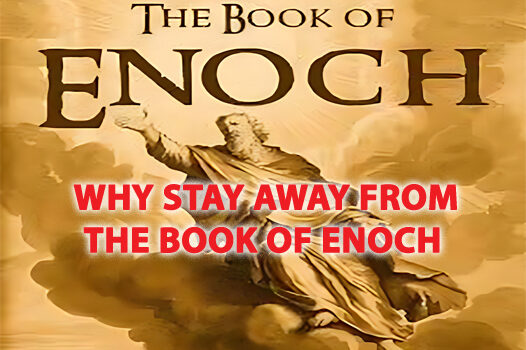The Book of Enoch, an ancient text shrouded in mystery, occupies a curious position within the vast landscape of religious literature. While its existence predates the New Testament and it is even referenced in the Epistle of Jude, the Book of Enoch remains excluded from the official canon of major religions like Judaism and Christianity. This article delves into the reasons behind this exclusion, exploring the book’s murky origins, its theological discrepancies, and the historical weight of canonical acceptance.
Questions of Authorship and Dating: Unveiling the Book’s Murky Origins
The Book of Enoch’s enigmatic status begins with the very foundation of its creation. Unlike many religious texts with clear attributions, the Book of Enoch is shrouded in the mists of time. Traditionally ascribed to Enoch, the great-grandfather of Noah, the book employs a literary device known as pseudepigraphy. In essence, the author presents the text as the work of a revered figure from the past to lend it legitimacy and authority. This ambiguity regarding authorship makes pinpointing the book’s exact origins a complex task. Scholars estimate the various sections were composed between the 3rd century BCE and the 1st century CE, further adding to the mystery surrounding the text’s development.
Contentual Dissonance: Exploring Theological Discrepancies
Perhaps the most significant reason for the Book of Enoch’s exclusion from mainstream religious canons lies in its content. The book delves into elaborate narratives that diverge from established theological doctrines. It presents detailed accounts of fallen angels, their interactions with humanity, and the resulting offspring known as the Nephilim. These narratives lack clear parallels in the core religious texts of Judaism and Christianity, creating a theological dissonance that made integration into the canon challenging. Additionally, the Book of Enoch features elaborate apocalyptic visions and celestial journeys, elements that some religious authorities deemed to be outside the realm of established doctrines.
The Weight of Historical Acceptance: Examining Canonical Exclusion
The concept of canonization, the process of establishing a collection of authoritative texts, carries significant weight within religious traditions. Throughout history, religious communities meticulously evaluated various texts based on factors like authorship, theological coherence, and historical accuracy. The Book of Enoch, with its uncertain origins and content discrepancies, fell short of these criteria for inclusion in the canons of Judaism and Christianity. This exclusion does not necessarily diminish the book’s historical or cultural significance, but it does limit its authority within these specific religious frameworks.
A Legacy of Intrigue: The Book of Enoch’s Enduring Influence
Despite its exclusion from major religious canons, the Book of Enoch continues to hold a captivating allure. Its esoteric narratives and themes have captivated scholars and religious enthusiasts for centuries. The book’s influence can be seen in certain religious movements like Ethiopian Christianity, where it remains part of the canon. Additionally, artistic expressions across various media, from literature to music, have drawn inspiration from the Book of Enoch’s fantastical imagery. The enduring interest in this ancient text underscores its potential to spark curiosity and reflection, even if it remains outside the boundaries of established religious canons.
Navigating the Book of Enoch: A Reader’s Guide
The Book of Enoch, having piqued your curiosity with its enigmatic status, might now beckon you to delve deeper. However, approaching this ancient text requires a discerning eye and an awareness of its complexities. This section serves as a reader’s guide, equipping you to navigate the book’s content with critical thinking and a nuanced understanding.
1. Approaching the Text with Context:
Before embarking on your exploration, it’s crucial to situate the Book of Enoch within its historical context. Remember, the various sections were composed over a vast period, reflecting the evolving beliefs and social anxieties of that era. Recognizing these historical nuances allows for a more informed interpretation of the text’s content.
2. Distinguishing Between Myth and Theology:
The Book of Enoch blends elements of myth, legend, and apocalyptic visions with pronouncements that might resemble religious doctrine. It’s vital to distinguish between these narrative styles. The elaborate fallen angel narratives, for instance, belong more to the realm of myth than established theological concepts.
3. Considering Pseudepigraphy and its Implications:
As discussed earlier, the Book of Enoch employs pseudepigraphy, attributing authorship to a revered figure like Enoch. Understanding this literary device helps you recognize that the text’s perspective might not be entirely objective. The author might be using Enoch’s name to lend weight to their own theological viewpoints.
4. Consulting Scholarly Resources:
The Book of Enoch’s complexities necessitate consulting scholarly resources to supplement your reading. Scholarly commentaries and critical analyses can provide valuable insights into the text’s historical context, its literary devices, and the various interpretations it has garnered over time.
5. Engaging with the Text Critically:
The Book of Enoch presents a unique opportunity to engage with a text that exists outside the mainstream religious canons. Approach it with a critical lens, questioning its claims and recognizing its potential biases. Consider how the text reflects the anxieties and worldviews of its time period.
Conclusion: A Journey of Exploration, Not Blind Acceptance
By adopting a critical and informed approach, your exploration of the Book of Enoch becomes a journey of discovery rather than blind acceptance. The book’s enduring intrigue lies in its ability to spark questions, challenge assumptions, and provide a glimpse into a fascinating, albeit enigmatic, chapter of religious history. Remember, the Book of Enoch is a conversation starter, not a definitive answer book. Let it ignite your curiosity and guide you on a path of further exploration and informed reflection.



